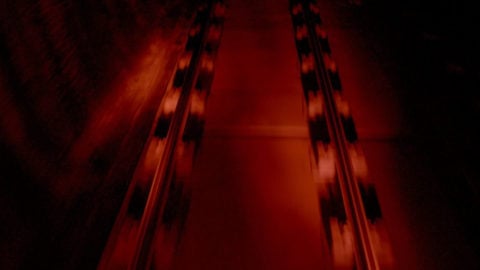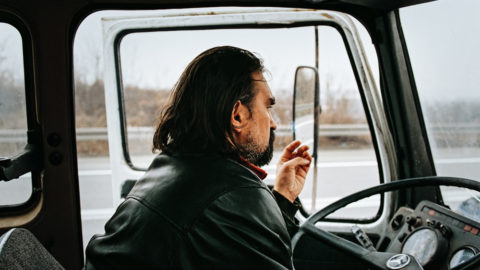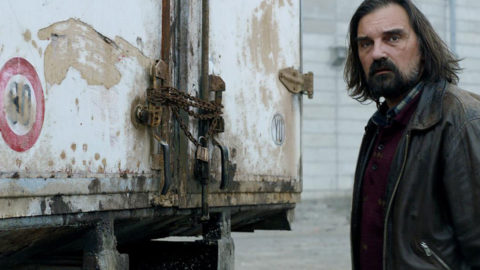Bearing Witness: The Load and Depth Two
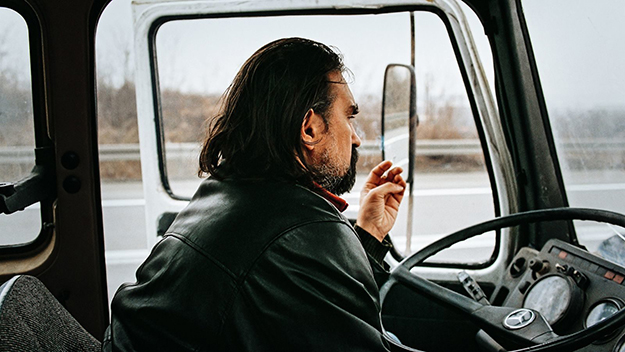
The Load (Ognjen Glavonic, 2018)
A road movie with a somber palette and a terse but subtle script, The Load (Teret, 2018) harbors depths below its minimalist surface, complexities that are evoked through glancing exchanges and potent details. The main character is first glimpsed as a reflection in the rain-fogged window of a van, his spectral face superimposed on a wintry landscape of wet black trees lit by the orange smear of a burning house. This ghostly image is a fitting introduction to a man who is mostly a silent witness moving through a wasted landscape. It is 1999, during the Balkan wars, and Vlada (Leon Lučev) is an unemployed factory worker who takes a job driving a truck from Kosovo to Belgrade. He is not told what he is hauling, and knows better than to ask. Throughout much of The Load, the camera stays with Vlada in the truck’s cramped cab, and in many ways his journey is mundane. Forced onto a detour, he loses his way, picks up a young hitch-hiker, stops at a roadhouse where a slightly sinister wedding party is in progress, and eventually makes it to his destination. Throughout the drive, occasional metallic thuds from the back call attention to the mystery of the cargo. The separation between the cab of the truck and the sealed, dirty-white trailer is a perfect symbol of compartmentalization, the safety and moral risks of ignorance.
Written and directed by Ognjen Glavonic, The Load is a rare kind of war movie with no scenes of combat or violence. It is about memory and absence, about the erasure and persistence of evidence, about the ethical boundaries of complicity. NATO bombs are falling, but we only see distant columns of smoke, handfuls of sparks in the sky, and a few burning cars along the road. The story centers on an atrocity that we never witness or learn the details of; this elliptical treatment gives the whole film an uneasy, haunted mood, and a parable-like simplicity. What happens here could be happening in any troubled part of the world, and the question anywhere would be the same: what is the responsibility of an ordinary citizen in a dirty war? In one scene, Vlada washes his hands in muddy water, making literal his predicament.
The bleakness and desolation of the film’s settings immerse us in a mood of numb melancholy and vague, ever-present dread. There is no need for references to the war; the landscape itself seems to grieve, all mud, mist, drizzle, gray-brown grass, wet gravel, and crumbling concrete. Lučev looks right at home in this environment, with his dark, heavy features corrugated by worry and fatigue. He matches the minimalism of the script with his quiet naturalism, but brings intensity and moral weight to the role of a man confronting the discovery that he is a tiny cog in a brutal system. Vlada’s gentleness comes out in his conversations with Paja (Pavle Čemerikić), a teenage hitch-hiker on his way to Munich, and later with his 16-year-old son. The director has noted that his interest in children and teenagers in the movie relates to his own youth (born in 1985, he was 14 at the time the film is set, and like these two young men, his first love was music). The script, he says, “slowly became a story about what one generation left to another. Not only the war, not only the ruins, not only the crime, but the silence and the stories they didn’t want to tell.”
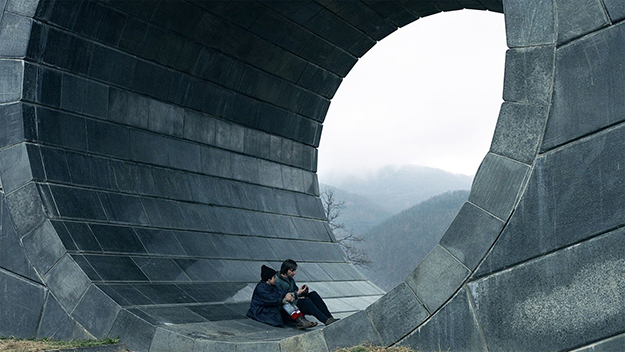
The Load (Ognjen Glavonic, 2018)
At dusk, Paja alights from the truck and wanders around the deserted outskirts of Belgrade, ending up at a yellow swing-set on which his own name is scratched. This scene, unconnected with the main plot, aches with a sense of what it is like to be young and alone and caught between a lost childhood and an uncertain future. From this bit of graffiti to postcards in a tavern restroom to framed photographs of generals to a huge, abstract war memorial on a hill, the movie is filled with historical traces and souvenirs, many going back to World War II. Vlada loses an inscribed cigarette lighter inherited from his father when it is stolen out of the truck. At the end of the film, he finally reveals the significance of this memento when he passes on to this son the story his father told him about a battle he fought in, and how years later he found his brother’s body marked by a tree that grew from the walnuts he always carried in his pockets.
The Load is a fictional narrative based on a real event, which Glavonic also addressed in his documentary Depth Two (2016). As he explained in an interview with Film Comment, the concept and script for The Load came first, but the production was delayed by struggles to come up with a budget; the documentary, created as an offshoot from the research he had done, helped to attract support for the feature. While it reveals many of the details that are left out of The Load, Depth Two is in its own way constructed around absence. The title refers to a secret operation to cover up massacres of civilians in Kosovo during the conflict between Serbs and Kosovar Albanian separatists; after the war ended, mass graves were discovered in the suburbs of Belgrade and a truck filled with bodies was pulled out of the Danube.
In Depth Two, the voices of victims, perpetrators, and witnesses recount the stories of the killings, the cover-up, and the discovery, over contemporary footage of locations where events took place. The counterpoint between the unidentified, disembodied voices and the images of rippling water, fog-shrouded cliffs, highways at night, the rubble of ruined houses, a tree engulfed in shredded plastic, creates an awareness of layers of time. In a story that is so much about the efforts to conceal a crime, the structure of the film highlights what has vanished—you would never know, looking at an ordinary highway or the lovely waters of the Danube, what happened in these spots—and what remains: recorded testimony and physical remnants. At the end, the film silently offers exhibits of distressed, charred clothing, personal papers, photographs, children’s drawings, which were exhumed with the bodies of the victims. In The Load, this preponderance of evidence is reduced to a necklace, a stump of a pencil, and a marble, flushed out when Vlada hoses the stink of putrefaction out of the back of his truck.
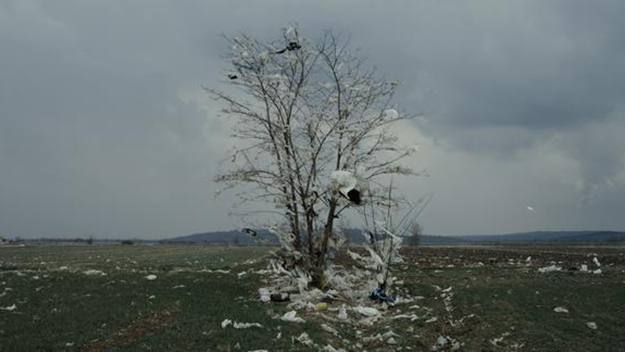
Depth Two (Ognjen Glavonic, 2016)
For obvious reasons, The Load has been compared to Henri-Georges Clouzot’s Wages of Fear (1953) and William Friedkin’s version of the same material, Sorcerer (1977), but there is none of the nail-biting, gear-grinding, explosive suspense of those movies, in which desperate men are hired to drive loads of explosives over bad roads. The Load has little action and no thrills, just a gradually thickening fog of dread. With its stripped-down plainness and amalgam of boredom and tension, the trucking movie it resembles most might be Hubert Cornfield’s Plunder Road (1957), in which a group of thieves tries to transport a stolen fortune across country in a moving van and a gas tanker. But what elevates The Load is the way it uses the simple structure of a road trip to illuminate a society at a moment in time, the way headlights fleetingly probe the darkness and then move on; and the way it confronts the silence around wartime atrocities not by breaking but by focusing on that silence. While it effectively harnesses genre structures—the road movie, the political thriller—its austere, elliptical style suggests other, very different models.
Perhaps because of a retrospective of the films of Abbas Kiarostami at the IFC Center in August, I found myself thinking of A Taste of Cherry (1997), which consists almost entirely of a man driving around a barren, lunar landscape, having conversations with younger men (and one older man) whom he picks up on the road; it is a film that is haunted by burial and exhumation. Although the revelation of what Mr. Badii (Homayoun Ershadi) wants from these men comes before the movie is half over—he is planning to kill himself and seeks someone to cover his body with earth—we never find out why he wants to end it all. That unanswered question is like the open grave on the hillside, unseen until the end but ever present, waiting to be filled. The combination of long-take realism—the camera parked inside the car, patiently watching Mr. Badii drive or recording awkward, repetitive conversations—and the withholding of key information and easy emotional connection demands patience and rigorous attention from the audience. But the rewards when they come are correspondingly greater, as isolation and opacity give way to moments of connection. Just as The Load builds to the almost magical-realist story about the walnut tree, A Taste of Cherry builds to a story another man tells Mr. Badii about how his own plan to commit suicide was diverted by the ripe mulberries he found when he climbed a tree to hang himself.
Beginning in almost unrelieved gloom, The Load ends with a surprisingly hopeful cast into the future, as Vlada’s son, listening to a cassette tape of Paja’s band, is sparked with desire to start his own. Young people in this film light fires, steal things, take off. A movie that insists we carry the weight of the truth also understands the value of forgetting.
The Load is now playing at Film at Lincoln Center.
Imogen Sara Smith is the author of In Lonely Places: Film Noir Beyond the City and Buster Keaton: The Persistence of Comedy, and has written for The Criterion Collection and elsewhere. Phantom Light is her regular column for Film Comment.



